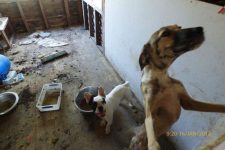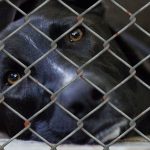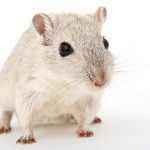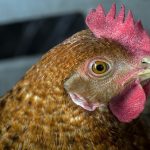Dead, Dying and Injured Dogs Discovered at Alleged Puppy Farm

By Blake O’Connor and Ugur Nedim
The RSPCA has reported that nearly 81 dogs and 10 cats have been seized from a property near Goondiwindi in Southern Queensland, including two animals that required emergency veterinary treatment at the scene.
RSPCA Queensland Chief Inspector Daniel Young called the incident “very disturbing”, saying in a statement:
“There was inadequate shelter and water and a number of the dogs were carrying injuries that needed urgent veterinary treatment.
“The conditions were really, really very disturbing indeed – just how the animals were being kept.
“There was one dog that was sharing a small space with a dog that was deceased and there were the remains of a number of corpses lying near dogs that were tethered”.
The dogs were mainly bulldogs, Staffordshire bull terriers and pit bull terriers, and have been moved to RSPCA’s Animal Welfare Campus for treatment and care.
The matter has been referred to police, who are appealing for anyone with further information to come forward.
Continuing problem
The RSPCA receives thousands of animal cruelty complaints every year, with insufficient resources to properly investigate all of them.
The organisation’s 2016 annual report says it investigated 14,953 complaints in NSW in that year alone, resulting in 63 successful prosecutions under the Prevention of Cruelty to Animals Act 1979. The reports says there were 259 successful prosecutions nationwide.
The RPSCA and police have extensive powers to investigate and prosecute cases of animal cruelty. Under the Act, they can enter properties, seize animals, issue fines and initiate criminal prosecutions.
However, there is little doubt that large numbers of cases remain unreported, or are not investigated or prosecuted.
And many are calling for tougher penalties in the wake of several publicised instances of shocking cruelty, including a case where an 18-year old was imprisoned for a month after kicking a kitten to death in a suburban park. The kitten’s liver had ruptured in two places.
In another case, Peter James Reardon was given a 12 month suspended sentence after allowing several hundred sheep on his Goulburn property to starve to death. Upon investigation, many sheep were barely alive and hard been starving for weeks, and crows were seen plucking at the eyes of the dead sheep, according to the RSPCA.
In yet another, the RSPCA called for the immediate closure of a Tasmanian abattoir in October 2016 due to repeated instances of severe animal cruelty. ABC News obtained a 30 minute video – taken over a four day period at the facility– which depicted abusive acts by an employee towards pigs and cattle, prolonged restraint of cattle, unnecessary suffering and multiple instances of ineffective stunning.
The law
Section 5 of the Prevention of Cruelty to Animals Act 1979 (NSW) (‘the Act’) makes it an offence to commit ‘an act of cruelty’ upon an animal.
Section 4 defines ‘cruelty’ as including any beating, kicking, wounding of an animal, exposure to excessive heat or cold or inflicting pain on an animal. Cruelty also includes failing to take reasonable care of an animal, or to take reasonable steps to alleviate pain or suffering, or to provide necessary veterinary treatment.
It is also an offence to authorise another person to commit an act of cruelty on an animal that you own, or are in charge of.
The maximum penalty for animal cruelty is 6 months imprisonment and/or a fine of $5,500 for an individual, or a $27,500 fine for a corporation.
Section 6 of the Act relates to ‘aggravated cruelty’, which is defined by section 4 as:
(a) causing the death, deformity or serious disablement of the animal, or
(b) the animal being so severely injured, so diseased or in such a physical condition that it is cruel to keep it alive.
The maximum penalty for aggravated animal cruelty is 2 years imprisonment and/or a fine of up to $22, 000 for individuals, or a fine of $110, 000 for corporations.
Section 530 of the Crimes Act 1900 (NSW) contains an additional offence of “serious animal cruelty” which includes torturing, beating or killing an animal. That offence comes with a maximum prison term of 5 years.
Defences
A whole range of defences to animal cruelty are contained in section 24 of the Act, including religious slaughter; see section 24(c)(i) below.
The section says that a person is not guilty of animal cruelty where the act was committed upon:
(a) (i) a stock animal–in the course of, and for the purpose of, ear-marking or ear-tagging the animal or branding, other than firing or hot iron branding of the face of, the animal,
(ii) a pig of less than 2 months of age or a stock animal of less than 6 months of age which belongs to a class of animals comprising cattle, sheep or goats–in the course of, and for the purpose of, castrating the animal,
(iii) a goat of less than 1 month of age or a stock animal of less than 12 months of age which belongs to the class of animal comprising cattle–in the course of, and for the purpose of, dehorning the animal,
(iv) a sheep of less than 6 months of age–in the course of, and for the purpose of, tailing the animal, or
(v) a sheep of less than 12 months of age–in the course of, and for the purpose of, performing the Mules operation upon the animal,in a manner that inflicted no unnecessary pain upon the animal,
(b) where the act of cruelty is done in the course of, and for the purpose of:
(i) hunting, shooting, snaring, trapping, catching or capturing the animal, or
(ii) destroying the animal, or preparing the animal for destruction, for the purpose of producing food for human consumption,
in a manner that inflicted no unnecessary pain upon the animal,
(c) in the course of, and for the purpose of, destroying the animal, or preparing the animal for destruction:
(i) in accordance with the precepts of the Jewish religion or of any other religion prescribed for the purposes of this subparagraph, or
(ii) in compliance with any duty imposed upon that person by or under this or any other Act,
(e) in the course of, and for the purpose of:
(i) carrying out animal research, or
(ii) supplying animals for use in connection with animal research,
in accordance with the provisions of the Animal Research Act 1985, or
(f) for the purpose of feeding a predatory animal lawfully kept by the person if:
(i) the act concerned was the release of live prey for the predatory animal, and
(ii) the diet of the predatory animal included animals of the kind released, and
(iii) the person believed on reasonable grounds that the feeding of live prey to the predatory animal was necessary for the predatory animal’s survival because the predatory animal would not eat a dead animal or meat from a dead animal.






